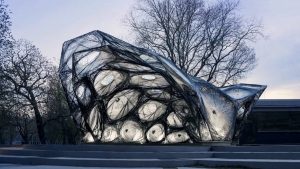/*
Veronica Wang
Section B
yiruiw@andrew.cmu.edu
Project-03
*/
var r1 = 100; //size of ellipse 1
var r2 = 80; //size of ellipse 2
var r3 = 120; //size of ellipse 3
var locX = 200; //rotation center of ellipses
var locY = 250; //rotation center of ellipses
var angle = 1; //first angle of rotation
var angle2 = 1; //second angle of rotation
var angle3 = 1; //third angle of rotation
var angle4 = 1; //fourth angle of rotation
var on = true; //background color
function setup() {
createCanvas(640, 480);
}
function draw() {
//change background between black and white
if (on == true) {
background(255);
} else {
background(0);
}
noStroke();
//red ellipse
fill(255, 0, 0, 150);
ellipse(320, 100, mouseX, mouseX);
//blue ellipse
fill(0, 0, 255, 150);
ellipse(locX,locY, mouseX, mouseX);
//green ellipse
fill(0, 255, 0, 150);
ellipse(400, 450, mouseX, mouseX);
//magenta ellipse
push();
translate(locX, locY);
rotate(radians(angle));
noStroke();
fill(255, 0, 255, 150);
ellipse(mouseX / 8 + 0.5 , mouseY / 8 + 1, r1 + mouseY / 2, r1 + mouseY / 2);
pop();
angle = angle + 1;
//cyan ellipse
push();
translate(locX + 10, locY);
noStroke();
fill(0, 255, 255, 150);
rotate(radians(angle));
ellipse(mouseX / 2 + 0.5 , mouseY / 2 + 1, r2 + mouseY / 1.5, r2 + mouseY / 1.5);
pop();
angle2 = angle2 + 2;
//yellow ellipse
push();
translate(locX + 50, locY);
noStroke();
fill(255, 255, 0, 150);
rotate(radians(angle));
ellipse(mouseX / 5 + 0.5 , mouseY / 6 + 1, r3 + mouseY / 3, r3 + mouseY / 3);
pop();
angle3 = angle3 + 0.5;
//white line
push();
translate(locX, locY + 50);
noStroke();
fill(255, 255, 255, 150);
rotate(radians(angle));
rectMode(CENTER);
rect(mouseX / 5 + 0.5 , mouseY / 6 + 1, 10, 1000);
pop();
angle3 = angle3 + 0.5;
//black line
push();
translate(100, 100);
noStroke();
fill(0, 0, 0, 150);
rotate(radians(angle));
rectMode(CENTER);
rect(mouseX / 2 + 0.5 , mouseY / 2 + 1, 20, 1000);
pop();
angle4 = angle4 - 1;
//white line apprears at mouse click
if (mouseIsPressed) {
if (mouseButton == LEFT) {
stroke(255);
strokeWeight(30);
} else {
stroke(0);
}
line(0, 200, width, 50);
}
}
//change background between black and white
function mousePressed() {
if (on == true) {
on = false;
} else {
on = true;
}
}
In this project I explored different color models and the relationship between colors. I played around with ellipses of colors red, green, blue, cyan, magenta, and yellow, as well as the overlaps of these colors. The background also changes from white to black.
![[OLD FALL 2018] 15-104 • Introduction to Computing for Creative Practice](../../../../wp-content/uploads/2020/08/stop-banner.png)

